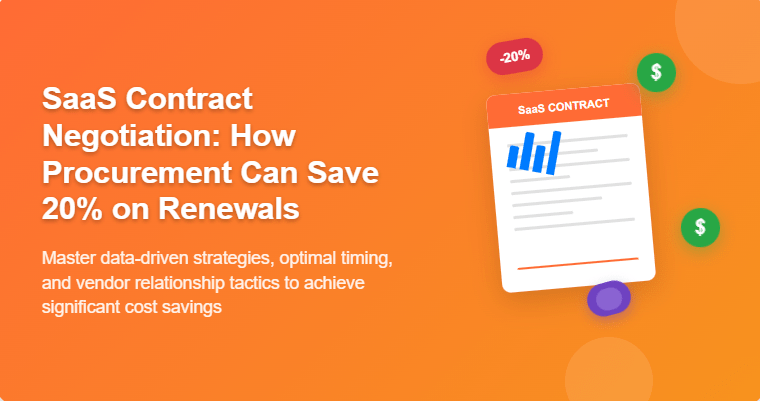
In today’s rapidly evolving business landscape, Software as a Service (SaaS) has become the backbone of modern organizations. As companies increasingly rely on cloud-based solutions for everything from customer relationship management to productivity tools, the strategic importance of effective SaaS contract negotiation has never been more critical.
The proliferation of SaaS applications has fundamentally transformed how businesses approach cloud cost optimization and software procurement. Organizations now manage dozens, if not hundreds, of SaaS subscriptions, making strategic vendor negotiations essential for controlling costs and maximizing value.
This comprehensive guide explores proven strategies that procurement teams can employ to achieve substantial cost savings during SaaS contract renewals. Through careful preparation, strategic timing, and data-driven approaches, organizations can reduce their SaaS spending by up to 20% while maintaining service quality and fostering positive vendor relationships.
Understanding the nuances of SaaS procurement and implementing effective negotiation tactics is crucial for businesses seeking to optimize their technology investments. The strategies outlined in this guide will empower procurement professionals to navigate complex vendor negotiations, secure favorable terms, and establish sustainable cost management practices that support long-term business growth.
What is SaaS Contract Negotiation?
SaaS contract negotiation is the strategic process of engaging with software vendors to establish mutually beneficial terms and conditions for service agreements. Unlike traditional software purchases that involved one-time licensing fees, SaaS contract negotiation focuses on subscription-based models that require ongoing vendor relationships and periodic renewals.
The negotiation process encompasses multiple dimensions beyond just pricing. Successful SaaS procurement involves negotiating service level agreements, data security provisions, compliance requirements, integration capabilities, and scalability options. These discussions directly impact both immediate costs and long-term operational efficiency.
Modern SaaS contract negotiation requires a deep understanding of usage patterns, business requirements, and market alternatives. Procurement teams must evaluate not only the immediate financial impact but also the strategic value that each SaaS solution brings to the organization. This holistic approach enables more effective vendor negotiations and better contract outcomes.
The complexity of SaaS agreements has evolved significantly as vendors offer increasingly sophisticated pricing models. Organizations must navigate tiered pricing structures, usage-based billing, and feature-specific subscriptions while ensuring they secure the most cost-effective arrangements for their specific needs.
The Growing Importance of SaaS Procurement
The SaaS market has experienced explosive growth, with global spending reaching unprecedented levels. According to industry research, organizations now use an average of 80+ SaaS applications, creating complex procurement challenges that require sophisticated vendor management strategies.
This proliferation has made SaaS spend management a critical business function. Companies that lack effective SaaS procurement processes often experience subscription sprawl, duplicate services, and inefficient spending patterns that can significantly impact their bottom line. The need for strategic vendor negotiations has become paramount.
The shift toward remote and hybrid work models has further accelerated SaaS adoption, making contract negotiation skills even more valuable. Organizations must balance the need for comprehensive software solutions with cost control objectives, requiring procurement teams to develop specialized expertise in SaaS vendor management.
Modern businesses face increasing pressure to demonstrate return on investment for their technology spending. This accountability requirement has elevated the importance of strategic SaaS contract negotiation, as procurement teams must secure favorable terms that support both operational efficiency and financial performance.
The competitive SaaS marketplace provides organizations with significant leverage during contract renewals, but only when procurement teams understand how to effectively utilize market dynamics and vendor relationships to their advantage.
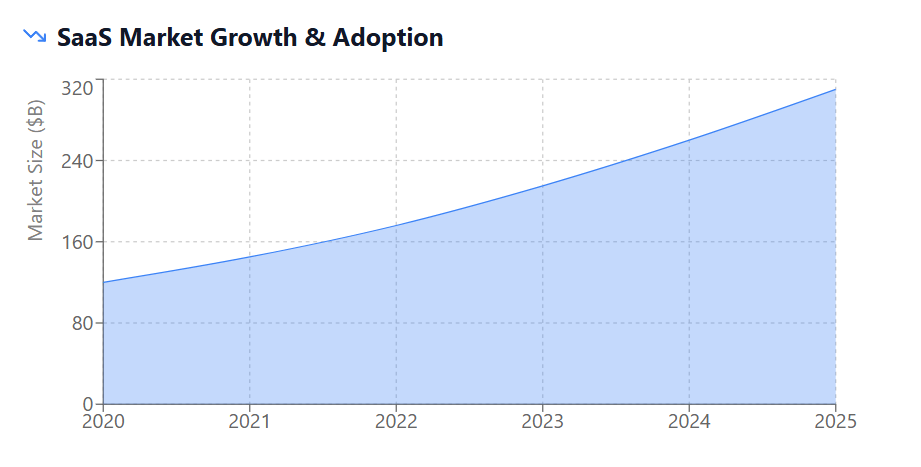
Pre-Negotiation Preparation Strategies
Effective SaaS contract negotiation begins long before the actual vendor discussions. Comprehensive preparation is essential for achieving optimal outcomes and maximizing cost savings during renewals.
Comprehensive Inventory and Assessment
Conduct a thorough inventory of all SaaS subscriptions, including contract terms, renewal dates, and usage patterns. This comprehensive assessment provides the foundation for strategic planning and helps identify immediate optimization opportunities. Many organizations discover significant subscription waste during this inventory process, including unused licenses, duplicate services, and over-provisioned features that represent immediate cost-saving opportunities.
Stakeholder Alignment and Requirements Gathering
Engage key stakeholders across the organization to understand requirements, priorities, and pain points related to existing SaaS solutions. This collaborative approach ensures that contract negotiations address real business needs rather than just cost reduction targets. Stakeholder input helps procurement teams understand which features are essential, which are nice-to-have, and where there might be flexibility for negotiation.
Market Research and Competitive Analysis
Understanding the competitive landscape is crucial for effective SaaS procurement. Research alternative solutions, compare pricing models, and identify market trends that may influence vendor positioning. This knowledge provides valuable leverage during contract renewals and helps establish realistic negotiation targets.
Budget Planning and Authorization
Establish clear budget parameters and secure appropriate authorization levels before entering negotiations. Understanding spending limits and decision-making authority prevents delays and enables more confident negotiation tactics. Budget clarity also helps set realistic expectations with vendors and provides a framework for evaluating proposed contract terms.
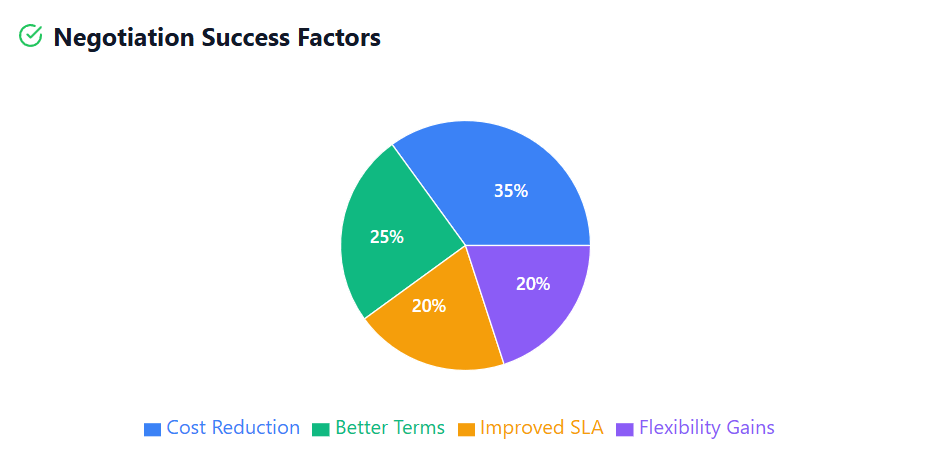
Timing Your SaaS Contract Negotiations
Strategic timing can significantly impact the success of SaaS contract negotiation efforts. Understanding vendor sales cycles, market conditions, and organizational factors helps procurement teams maximize their negotiating leverage.
Vendor Sales Cycles and Quarterly Pressure
Most SaaS vendors operate on quarterly sales cycles with significant pressure to meet revenue targets at quarter-end. Timing contract renewals to coincide with these periods can provide substantial leverage for cost reduction negotiations. End-of-quarter negotiations often yield better pricing, extended payment terms, and additional value-added services.

Market Timing Considerations
Economic conditions, industry trends, and competitive pressures influence vendor willingness to negotiate. During economic uncertainty, vendors may be more flexible on pricing to maintain customer relationships and revenue stability. Understanding broader market dynamics helps procurement teams adjust their negotiation strategies accordingly.
Internal Timing Factors
Align negotiation timing with internal budget cycles, strategic planning processes, and operational requirements. This coordination ensures that contract outcomes support broader organizational objectives and resource allocation decisions. Consider renewal dates for related services and potential consolidation opportunities to maximize negotiation leverage.
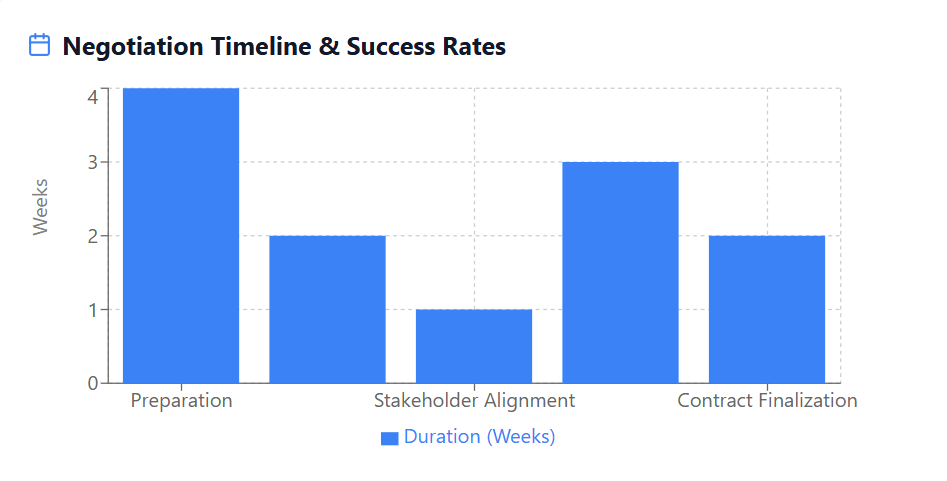
Leveraging Data in Vendor Negotiations
Data-driven approaches to SaaS contract negotiation provide significant advantages over traditional procurement methods. Comprehensive analytics enable procurement teams to make informed decisions and present compelling arguments during vendor discussions.
Usage Analytics and Performance Metrics
Detailed usage analytics provide objective evidence for negotiation discussions. When vendors see clear data showing how their services are utilized, they’re more likely to offer pricing that reflects actual value delivery rather than theoretical maximum usage. Performance metrics help identify areas where vendors may not be meeting expectations, creating opportunities for service level adjustments or compensation.
Benchmarking and Market Comparisons
Industry benchmarking data provides context for pricing discussions and helps establish reasonable cost targets. Procurement teams should research market rates, competitor pricing, and industry standards to support their negotiation positions. Comparative analysis across similar organizations can reveal opportunities for improved pricing or enhanced service levels.
Financial Impact Analysis
Quantifying the business impact of SaaS investments strengthens negotiation positions and justifies contract terms. Calculate productivity improvements, cost savings, and operational efficiency gains to demonstrate value delivery and support future investment decisions. This analysis helps vendors understand the strategic importance of maintaining your business relationship.
Contract Terms That Drive Cost Savings
Beyond headline pricing, numerous contract provisions can significantly impact the total cost of SaaS solutions. Understanding these terms and negotiating them effectively is crucial for achieving sustainable cost reductions.
Pricing Escalation and Multi-Year Discounts
Negotiate reasonable limits on annual price increases to prevent unexpected cost escalations. Many vendors include automatic escalation clauses that can significantly increase costs over multi-year agreements. Consider tying price increases to specific performance metrics rather than accepting blanket annual increases. Evaluate multi-year contract options that provide significant cost savings in exchange for longer commitments, but balance cost savings against flexibility requirements.
Usage-Based Billing Optimization
For usage-based SaaS solutions, negotiate pricing tiers and overage charges that align with your consumption patterns. Understanding your usage trends helps secure more favorable rate structures and prevents costly surprises during peak demand periods. Consider negotiating commitments that provide discounted rates in exchange for minimum usage guarantees.
Payment Terms and Flexibility Provisions
Negotiate payment terms that support cash flow management and provide additional cost savings opportunities. Extended payment periods, early payment discounts, and flexible billing arrangements can reduce the effective cost of SaaS solutions. Some vendors offer significant discounts for annual prepayments or extended payment terms.
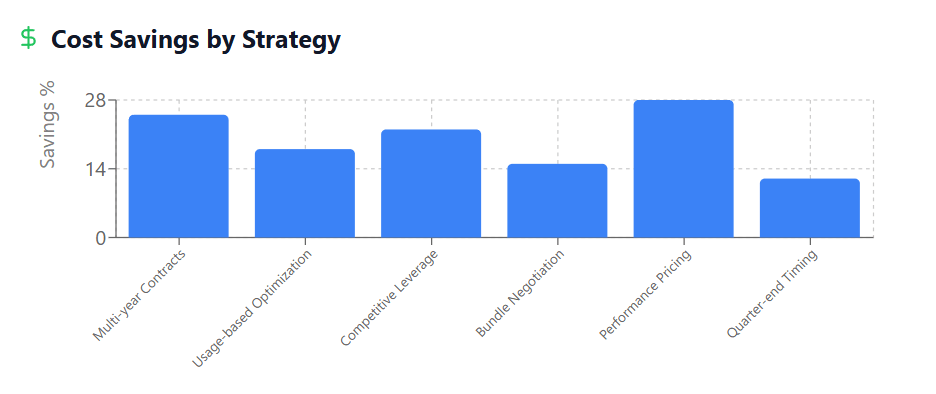
Common SaaS Negotiation Mistakes to Avoid
Understanding common pitfalls in SaaS contract negotiation helps procurement teams avoid costly mistakes and achieve better outcomes. Learning from these frequent errors can significantly improve negotiation effectiveness.
Focusing Solely on Price
While cost reduction is important, focusing exclusively on price can lead to suboptimal contract outcomes. Consider total value, service quality, integration capabilities, and long-term strategic alignment when evaluating vendor proposals. Overly aggressive price negotiations may result in reduced service levels or limited support that ultimately increases total cost of ownership.
Insufficient Usage Analysis
Proceeding with negotiations without comprehensive usage data weakens bargaining positions and may result in inappropriate contract terms. Without usage data, organizations may commit to service levels that exceed their needs or fail to secure adequate capacity for their requirements.
Inadequate Market Research and Poor Timing
Failing to research alternatives and market conditions limits negotiation leverage and may result in accepting unfavorable terms. Rushing into negotiations without adequate preparation significantly reduces negotiation effectiveness. Last-minute negotiations often favor vendors because procurement teams lack time for thorough analysis and strategic planning.
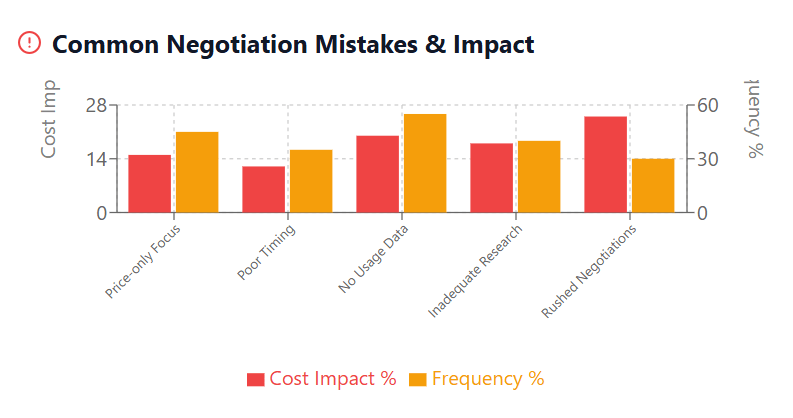
Advanced Negotiation Tactics
Sophisticated procurement teams employ advanced negotiation tactics that go beyond basic price discussions. These strategies require careful preparation and execution but can yield substantial additional benefits.
Competitive Leverage Strategies
Effectively utilizing competitive alternatives requires more than just identifying options. Successful procurement teams develop detailed alternative scenarios and use them strategically during negotiations without creating adversarial relationships. The key is demonstrating credible alternatives while maintaining positive vendor relationships.
Bundle and Unbundle Negotiations
Strategic bundling or unbundling of services can provide significant cost advantages. Analyze whether consolidating services with fewer vendors or separating services across multiple specialists provides better value and negotiation leverage. Sometimes vendors offer attractive bundle pricing to increase customer stickiness, while other situations may favor unbundled approaches.
Performance-Based Contract Structures
Consider performance-based contract structures that tie vendor compensation to specific business outcomes or service levels. These arrangements align vendor interests with your success and can drive superior performance. Performance partnerships encourage vendors to invest in relationship success and continuously improve service delivery.
How Binadox Enhances SaaS Contract Negotiation
Effective SaaS contract negotiation requires comprehensive visibility into usage patterns, costs, and vendor performance. Binadox provides the analytics and insights necessary to strengthen negotiation positions and achieve optimal contract outcomes.
Comprehensive Usage Analytics
Binadox delivers detailed usage analytics that provide objective evidence for contract negotiations. Understanding exactly how SaaS solutions are utilized across your organization enables more informed discussions with vendors about appropriate service levels and pricing. The platform tracks user adoption rates, feature utilization, and performance metrics that help identify optimization opportunities and negotiation leverage points.
Cost Optimization and Renewal Management
The platform identifies underutilized subscriptions, duplicate services, and optimization opportunities that can be addressed during contract renewals. Binadox’s comprehensive cost analysis helps procurement teams understand the true financial impact of each SaaS investment, enabling more strategic decisions about vendor relationships.
Binadox provides proactive renewal management capabilities that ensure procurement teams have adequate time for strategic planning and preparation. The platform tracks renewal dates, contract terms, and vendor performance to support effective negotiation timing and coordination across multiple vendors.
Vendor Performance Monitoring
The platform monitors vendor performance against contractual commitments, providing objective data for renewal discussions. When vendors see that you have clear visibility into service delivery, they’re more likely to offer competitive terms and maintain high performance standards. Performance data helps identify areas where vendors may not be meeting expectations, creating opportunities for service level adjustments.
Real-World Success Examples
Understanding how other organizations have achieved significant cost savings through strategic SaaS contract negotiation provides valuable insights for procurement teams.
Enterprise Software Consolidation
A Fortune 500 company achieved 25% cost reduction by consolidating multiple point solutions with a comprehensive enterprise platform. The procurement team used detailed usage analytics to demonstrate overlapping functionality and negotiate a consolidated contract that eliminated redundancy while maintaining functionality. The negotiation leveraged competitive alternatives and multi-year commitment options to secure favorable pricing.
Performance-Based Pricing Model
A technology startup negotiated a performance-based contract structure that tied vendor pricing to specific business metrics. This approach reduced fixed costs during the company’s growth phase while providing the vendor with upside potential as the business scaled. The arrangement included usage-based pricing with volume discounts and performance bonuses tied to system availability metrics.
Multi-Vendor Coordination Strategy
A healthcare organization coordinated negotiations across multiple SaaS vendors to achieve comprehensive cost reductions and improved integration capabilities. The strategic approach leveraged timing and competitive dynamics to secure favorable terms across the entire software stack. The procurement team used cloud cost optimization strategies and comprehensive usage data to demonstrate sophisticated vendor management capabilities.
Measuring Success and Future Trends
Establishing clear metrics for evaluating negotiation outcomes ensures continuous improvement and demonstrates procurement value. Track direct cost savings, total cost of ownership improvements, and operational performance indicators following contract negotiations. Monitor service quality, vendor responsiveness, and user satisfaction to ensure that cost optimization efforts don’t negatively impact business operations.
The SaaS marketplace continues evolving rapidly, with artificial intelligence and machine learning technologies increasingly being applied to contract analysis and negotiation support. Organizations that adopt AI-enhanced procurement capabilities gain significant advantages through better preparation and data-driven negotiation strategies.
Environmental, social, and governance factors are becoming increasingly important in vendor selection and contract negotiations. The trend toward hybrid cloud and multi-cloud strategies is also influencing SaaS contract negotiations, requiring greater flexibility and integration capabilities.
Conclusion
Strategic SaaS contract negotiation has emerged as a critical capability for modern organizations seeking to optimize their technology investments while maintaining operational excellence. The potential for achieving 20% or greater cost savings through effective vendor negotiations makes procurement expertise essential for business success.
The strategies outlined in this guide provide a comprehensive framework for approaching SaaS contract renewals with confidence and achieving optimal outcomes. From thorough preparation and strategic timing to data-driven approaches and relationship building, successful negotiation requires a multifaceted approach that balances immediate cost objectives with long-term value creation.
Organizations that invest in developing sophisticated SaaS procurement capabilities gain significant competitive advantages through reduced costs, improved vendor relationships, and better alignment between technology investments and business objectives. The complexities of modern SaaS markets make professional negotiation skills and comprehensive market knowledge essential for achieving optimal results.
As the SaaS ecosystem continues evolving, procurement teams must adapt their strategies to address new challenges and opportunities. By implementing the practices and strategies discussed in this guide, organizations can establish sustainable cost management processes that support long-term business growth while maximizing the value of their technology investments.
The most successful organizations view SaaS contract negotiation as a strategic capability rather than a tactical procurement activity. This perspective enables more sophisticated approaches that deliver superior outcomes and support broader business objectives through optimized vendor relationships and cost-effective technology solutions.

